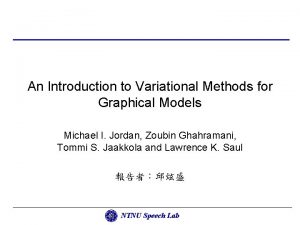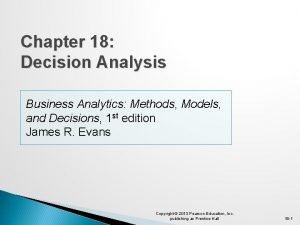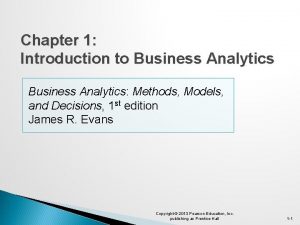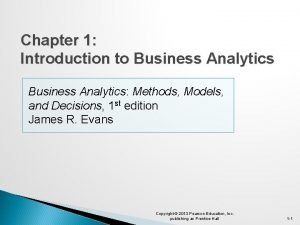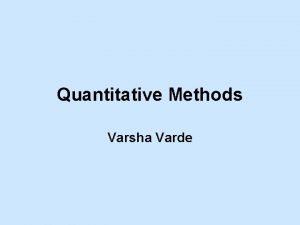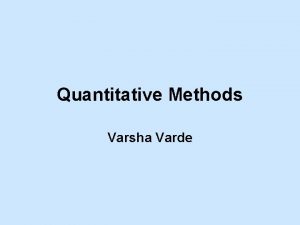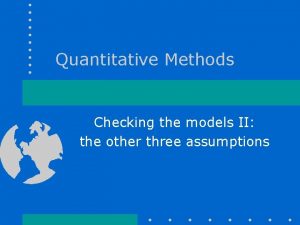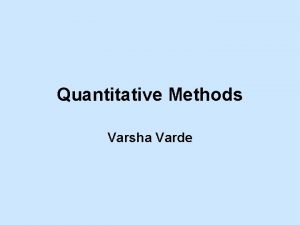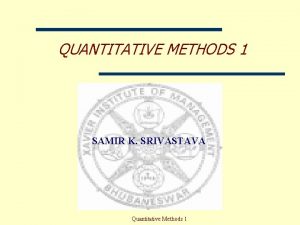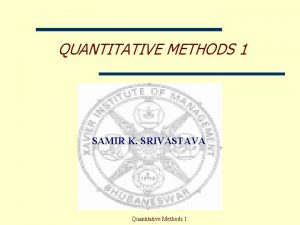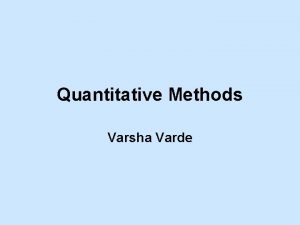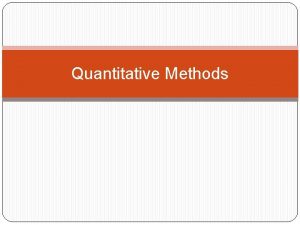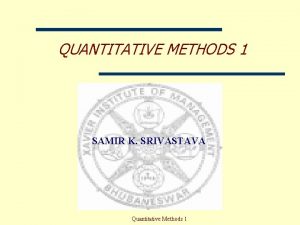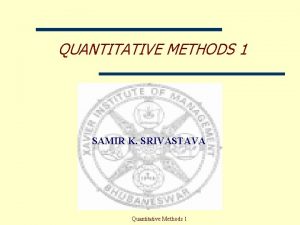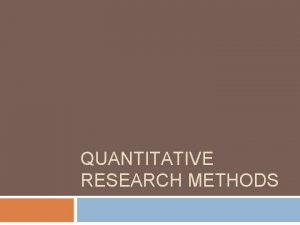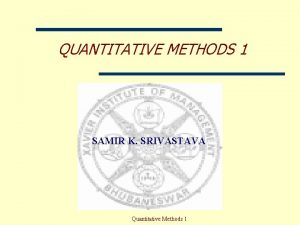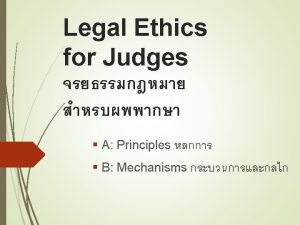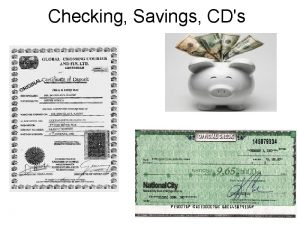Quantitative Methods Checking the models I independence Checking


























- Slides: 26

Quantitative Methods Checking the models I: independence

Checking the models I: independence Assumptions of GLM

Checking the models I: independence Assumptions of GLM BACAFTER = BACBEF+TREATMNT (Model Formula) BACAFTER = m + b BACBEF + (Model) TREATMNT Coef 1 1 2 2 3 - 1 - 2 + TREATMNT Coef PREDICTED 1 -1. 590 BACAFTER = -0. 013 + 0. 8831 BACBEF + 2 -0. 726 3 2. 316 (Fitted Value Equation or Best Fit Equation)

Checking the models I: independence Assumptions of GLM BACAFTER = BACBEF+TREATMNT (Model Formula) BACAFTER = m + b BACBEF + (Model) TREATMNT Coef 1 1 2 2 3 - 1 - 2 +

Checking the models I: independence Assumptions of GLM BACAFTER = m + b BACBEF + (Model) TREATMNT Coef 1 1 2 2 3 - 1 - 2 +

Checking the models I: independence Assumptions of GLM BACAFTER = m + b BACBEF + (Model) Assumptions of GLM Independence Homogeneity of variance Normality of error Linearity/additivity TREATMNT Coef 1 1 2 2 3 - 1 - 2 +

Checking the models I: independence Assumptions of GLM BACAFTER = m + b BACBEF + (Model) Assumptions of GLM Independence Homogeneity of variance Normality of error Linearity/additivity TREATMNT Coef 1 1 2 2 3 - 1 - 2 +

Checking the models I: independence Independence in principle

Checking the models I: independence Heterogeneous data

Checking the models I: independence Heterogeneous data

Checking the models I: independence Heterogeneous data

Checking the models I: independence Heterogeneous data

Checking the models I: independence Heterogeneous data

Checking the models I: independence Heterogeneous data

Checking the models I: independence Repeated measures

Checking the models I: independence Repeated measures

Checking the models I: independence Repeated measures

Checking the models I: independence Repeated measures

Checking the models I: independence Repeated measures Single summary approach Multivariate approach Few summaries approach

Checking the models I: independence Repeated measures name C 100 ’wtg’ let wtg=LOGWT 20 -LOGWT 3 glm wtg=diet GLM RATE=DIET LET LET LET K 3=3 -31/3 ! 31/3 is the average of K 8=8 -31/3 ! 3, 8 and 20 K 20=20 -31/3 K 1=K 3**2+K 8**2+K 20**2 RATE=(K 3*LOGWT 3+K 8*LOGWT 8+K 20*LOGWT 20)/K 1

Checking the models I: independence Repeated measures

Checking the models I: independence Repeated measures GLM LOGWT 60 RATE = DIET; MANOVA; NOUNIVARIATE.

Checking the models I: independence Nested data

Checking the models I: independence Nested data

Checking the models I: independence Detecting non-independence In principle: would knowing the error for one or more datapoints help you guess the error for some other datapoint? Experiments: Does the datapoint correspond to the level of randomisation? Observations: Are there groups of datapoints which are very likely to have similar residuals? Be suspicious of - Too many datapoints - Implausible results - Repeated measures

Checking the models I: independence Last words… • Independence is a key assumption, and is the most problematic in practice • Always be alert to possible violations • Know what can be done at the analysis stage • Realise that mistakes at the design stage are often unrecoverable at analysis Checking the models II: the other three assumptions Read Chapter 9
 Integrating qualitative and quantitative methods
Integrating qualitative and quantitative methods Sampling methods in qualitative and quantitative research
Sampling methods in qualitative and quantitative research Difference between modals and semi modals
Difference between modals and semi modals An introduction to variational methods for graphical models
An introduction to variational methods for graphical models The engineering design of systems: models and methods
The engineering design of systems: models and methods Decision tree business analytics
Decision tree business analytics Scope of business analytics
Scope of business analytics Business analytics methods models and decisions
Business analytics methods models and decisions Linear programming models: graphical and computer methods
Linear programming models: graphical and computer methods Wax pattern fabrication
Wax pattern fabrication Lời thề hippocrates
Lời thề hippocrates Sự nuôi và dạy con của hươu
Sự nuôi và dạy con của hươu Lp html
Lp html đại từ thay thế
đại từ thay thế Vẽ hình chiếu vuông góc của vật thể sau
Vẽ hình chiếu vuông góc của vật thể sau Quá trình desamine hóa có thể tạo ra
Quá trình desamine hóa có thể tạo ra Công thức tính độ biến thiên đông lượng
Công thức tính độ biến thiên đông lượng Thế nào là mạng điện lắp đặt kiểu nổi
Thế nào là mạng điện lắp đặt kiểu nổi Các loại đột biến cấu trúc nhiễm sắc thể
Các loại đột biến cấu trúc nhiễm sắc thể Vẽ hình chiếu đứng bằng cạnh của vật thể
Vẽ hình chiếu đứng bằng cạnh của vật thể độ dài liên kết
độ dài liên kết Môn thể thao bắt đầu bằng chữ đua
Môn thể thao bắt đầu bằng chữ đua Sự nuôi và dạy con của hổ
Sự nuôi và dạy con của hổ Bổ thể
Bổ thể điện thế nghỉ
điện thế nghỉ Một số thể thơ truyền thống
Một số thể thơ truyền thống Biện pháp chống mỏi cơ
Biện pháp chống mỏi cơ



